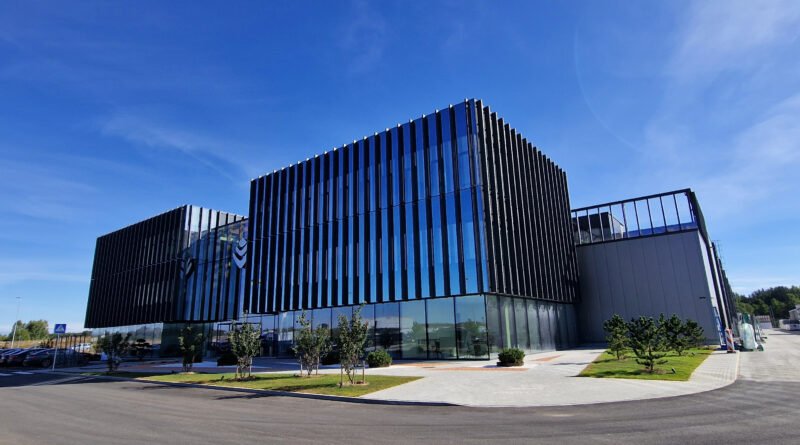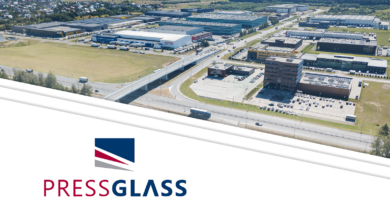Manufacturer of Aluminum and Glass Facades KGCG is moving to new premises
Facility: KGCG Factory and Administrative Building
Year: 2021-2022
Project manager, head of the architectural part of the project: Aurimas Daunoravičius
Project architects: Aurimas Daunoravičius, Ugnė Petrevičiūtė
General contractor: Conresta UAB
Interior designers: DVI Design
Lina Svaldenienė
A modern factory and office of KG Constructions Group (KGCG) approximately 15 kilometers from the center of Vilnius was built within a year and a half. Buildings ordered by successful Lithuanian business groups reflect global trends both in their planning and installation, where special attention is paid to business needs and the comfort of employees. The new headquarters of the building materials manufacturer, with its shiny aluminum and glass facades, is no exception.
Good looking factory
KGCG, a leader in the design, production, transportation and installation of façade glass and aluminum structures made a mature decision to increase manufacturing production and move the administration to new, modern premises a couple of years ago.

The new building will properly represent the image of KGCG.
“It is not just a regular factory. The production premises replicates the architecture of office. The office part is separated from the production premises by glass, so employees will be able to see each other. We have invested in the design a lot to get the building which would represent the Group. ”
KGCG CEO Linas Karžinauskas
The building project implements a functional program: installation of the expected number of workplaces, efficient arrangement of production equipment, creation of convenient internal logistics. KGCG gave the architect a lot of creative freedom, just expected that architecture would reflect the company’s core values - vitality, transparency, sustainability.
Although the company manufactures facade elements and the possibilities for showing up on the facades of the building were virtually unlimited, several high-quality facade systems with excellent thermal properties, but with a restrained appearance, were chosen by mutual agreement of the customer and the architect. Uniform façade systems maintains the connection and integrity of different parts of the building.
Attractive workplaces
Most of the modern office plans comply with the concept of open workplace, where individual and common spaces are combined and the comfort of employees is highly valued. The concept of comfort here includes both the noise level and the optimal lighting of the spaces and the microclimate controlled by automated building systems. So the offices differ more due to the choice of materials and the professionalism of the builders. Office, shop floor and recreation areas create positive experiences and become not only a part of the image, but also a lure to attract new talents.
For the relaxation and convenience of the employees, the new facility has a sports court, where there will be tennis courts and a basketball court, a gym, many rest areas, canteens, and changing rooms.
“Factory staff will have especially good working conditions. Although their premises are in a different location, both the interior and the equipment are identical to the premises of office workers. We have a lot of young people in our group who see that their friends who work downtown can go to the company gym or canteen. We also create a competitive work environment”
L.Karžinauskas
The employees will finally move to the new premises at the end of autumn. “Almost the entire administration will move from the old factory. Some employees are happy to relocate, others, who are coming from the other side of the city, may need to be encouraged. In total, there will be 700-800 employees here, when production reaches its peak”, L. Karžinauskas calculates.
The company’s second factory, which is twice as large as the first one in Parapijoniškės, will allow to abandon work in two shifts, thus, both higher efficiency and better motivation are expected. Only robots will not count working time. 3 robots that cut, drill and mill profiles will work in the workshop. The production facility is also equipped with eight assembly lines.
I think that today our factory is the largest and newest in Northern Europe, there are really no such resources within a radius of several thousand kilometers.
L. Karžinauskas.
Aesthetic and sustainable architecture
The design of the production premises and office building aims to meet the requirements of aesthetic architecture and sustainable construction and operation. Design and construction were energy-wise: the building has an A+ energy efficiency class. The A+ energy efficiency class was achieved by using façade systems with good thermal properties and sandwich-type multilayer panels, traditionally used in this type of building. The roofs are insulated with polyurethane (PIR) insulating panels.
In order to increase the efficiency of the building as much as possible and at the same time to reduce its impact on the environment, it is planned to install a 500 kW solar power plant on the roof of the building with the possibility of immediately using the energy for production purposes without incurring losses due to transmission. The solar panels should generate enough electricity to cover 80 to 100 percent of the electricity used in production.
The building is built from prefabricated reinforced concrete structures. Precast perforated reinforced concrete panels on Deltabeam beams were used for the ceilings, and profiled decking on metal beams was used for the roof structures. The factory building also consists of reinforced concrete columns and walls, and the reinforced concrete slabs used for the ceilings rest on metal trusses. The roof structure is a network of metal trusses with a metal profiled deck covering.
KGCG exports most of its products to Scandinavian countries, so the aesthetic principles characteristic of the cultures of these countries are also reflected in the architectural solutions of its headquarters building. The building’s main compositional axis and connecting element is the atrium, an open space at the building’s main entrance. As a physically expressed element of transparency, it connects all parts of the building – the production part (symbolically – vitality) and the blocks of administrative premises on the left and right sides of the atrium (symbolically – sustainability), ensuring functional and visual connections between them.
From a technical point of view, this part of the building is special because it uses large-sized (6 m high) glass units for its external walls, which allow to visually erase the boundaries between the inside and outside of the building and the atrium and the production workshop. The structures of the bridges, elevator and stairs in the atrium are covered with stainless steel sheets, optically masking the real sizes of the structures with their mirror surfaces and giving the impression of additional lightness.




